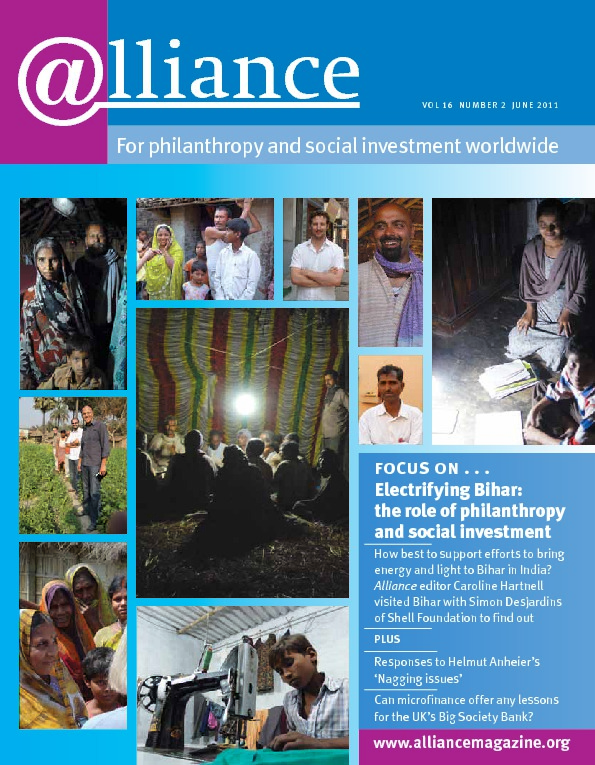These publications are produced by two different and very reputable philanthropy organizations, Forum for Active Philanthropy in Berlin, Germany and wise Philanthropy Advisors, based in Geneva, Switzerland. The publications I have reviewed are most interesting but how well are they likely to succeed in communicating with their target audience?
We live in a globalized, digitalized world of lightning-fast communications. It only takes a moment to take a short film with our cellphones and put it on Youtube and within seconds it will reach millions of people throughout the world. This is of course a great opportunity when wanting to convey a message, but it also produces a great media buzz which makes it hard to make your voice heard.
Given this state of affairs, how can a philanthropy organization reach its target groups by means of a printed publication? Traditionally, the target group can be defined as a family making donations, often for purposes close to the heart.
I believe that while society is becoming more and more individualistic, individuals are increasingly willing to take responsibility for the society we live in. We need to discharge that responsibility with structure and strategy, in the same way we meet challenges in our companies and professions. So the demand for professional philanthropy organizations increases.
The aim of these publications is to enable donors to focus their efforts in a strategic way. As such, both provide good insights. Will the publications help the philanthropy organizations to achieve their aims and to build their brands and create trust? For me, there are two aspects to communication: a functional one (to convey the information and messages in the way it is supposed to) and an emotional one (to engage with the feelings). To be completely successful, communication must satisfy both needs, for facts and feelings.
 Storytelling is generally deemed an excellent way to communicate. In Panic in the Chicken Coop, Forum for Active Philanthropy accepts this challenge. The agonies of problem solving are discussed by the hens in a chicken coop while the cunning fox presents the obvious external threat. With great humour it explains the different methods for problem solving and strategies for making donations. Finally comes the big moment when the great plan is revealed – a great plan with all the correct strategic elements. And yes, it works.
Storytelling is generally deemed an excellent way to communicate. In Panic in the Chicken Coop, Forum for Active Philanthropy accepts this challenge. The agonies of problem solving are discussed by the hens in a chicken coop while the cunning fox presents the obvious external threat. With great humour it explains the different methods for problem solving and strategies for making donations. Finally comes the big moment when the great plan is revealed – a great plan with all the correct strategic elements. And yes, it works.
It’s a great saga and it delivers what the brand experts like to see: it satisfies both functional and emotional requirements. The publication explains methods and strategies and manages to involve the reader’s feelings. But it would gain a lot by being shorter and getting straight to the point.
 Good ideas and new ideas is a traditional descriptive publication despite its use of graphics throughout. It is clear in its purpose and describes the different focus areas and problems a donor will come across. The publication is thorough and enlightening. It gives the reader a broad perspective on philanthropy and family. Interesting topics such as heart and head, global or local, and how to involve the younger generation are discussed in an instructive and clear way. It clearly delivers on the functional dimension, but even if it discusses the emotional perspective it never really reaches the heart.
Good ideas and new ideas is a traditional descriptive publication despite its use of graphics throughout. It is clear in its purpose and describes the different focus areas and problems a donor will come across. The publication is thorough and enlightening. It gives the reader a broad perspective on philanthropy and family. Interesting topics such as heart and head, global or local, and how to involve the younger generation are discussed in an instructive and clear way. It clearly delivers on the functional dimension, but even if it discusses the emotional perspective it never really reaches the heart.
These two publications provide great information on how to take a strategic perspective on your philanthropic efforts. One uses storytelling and humour as a way to engage and reach out, while the other is traditional and very clear in tone. I will refer to both publications in future, but for different purposes. I will get inspired and get strategic methods in Berlin and get all the facts in Geneva.
In this digital and lightning-fast world I recommend both Berlin and Geneva to use their websites to maximize their efforts. The use of interactive channels increases the chance of reaching younger generations of donors such as the new entrepreneurs who are creating the new philanthropic families. I can see how websites can be used as communities for younger donors to exchange information and opinions on philanthropic projects. I am looking forward to following developments in the communications efforts of philanthropy organizations.
Carolina Wallenius is a communications expert and involved in organizations such as Mentor Sweden. Email c.wallenius@telia.com
To order
Panic in the Chicken Coop can be downloaded at http://www.activephilanthropy.org/en/services/toolbox.html
Good ideas and new ideas can be downloaded from http://www.wise.net




Comments (0)